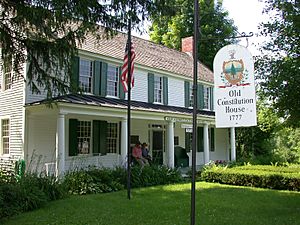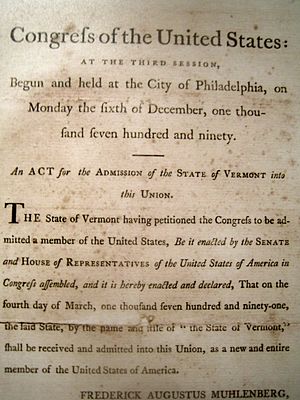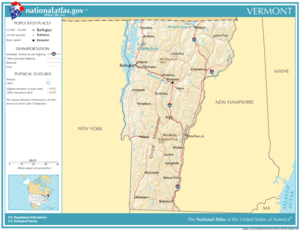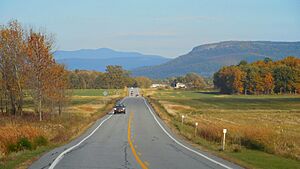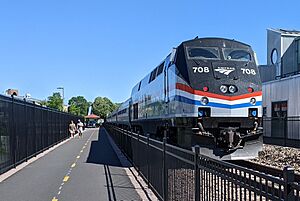Vermont facts for kids
Quick facts for kids
Vermont
|
|||
|---|---|---|---|
|
|||
| Nickname(s):
The Green Mountain State
|
|||
| Motto(s):
Freedom and Unity and Stella quarta decima fulgeat (May the fourteenth star shine bright)
|
|||
| Anthem: These Green Mountains | |||
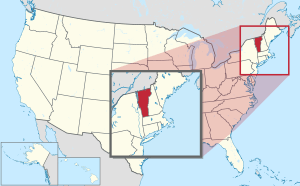
Location of Vermont within the United States
|
|||
| Country | United States | ||
| Before statehood | Vermont Republic | ||
| Admitted to the Union | March 4, 1791 (14th) | ||
| Capital | Montpelier | ||
| Largest city | Burlington | ||
| Largest county or equivalent | Chittenden | ||
| Largest metro and urban areas | Burlington | ||
| Legislature | General Assembly | ||
| • Upper house | Senate | ||
| • Lower house | House of Representatives | ||
| Judiciary | Vermont Supreme Court | ||
| U.S. senators | Bernie Sanders (I) Peter Welch (D) |
||
| U.S. House delegation | Becca Balint (D) (list) | ||
| Area | |||
| • Total | 9,616 sq mi (24,923 km2) | ||
| • Land | 9,250 sq mi (23,957 km2) | ||
| • Water | 382 sq mi (989 km2) 4.1% | ||
| Area rank | 45th | ||
| Dimensions | |||
| • Length | 160 mi (260 km) | ||
| • Width | 80 mi (130 km) | ||
| Highest elevation | 4,395 ft (1,340 m) | ||
| Lowest elevation | 95 ft (29 m) | ||
| Population
(2024)
|
|||
| • Total | |||
| • Rank | 49th | ||
| • Density | 70/sq mi (27/km2) | ||
| • Density rank | 31st | ||
| • Median household income | $81,200 (2023) | ||
| • Income rank | 16th | ||
| Demonym(s) | Vermonter | ||
| Language | |||
| • Official language | None | ||
| • Spoken language | |||
| Time zone | UTC−05:00 (Eastern) | ||
| • Summer (DST) | UTC−04:00 (EDT) | ||
| USPS abbreviation |
VT
|
||
| ISO 3166 code | US-VT | ||
| Traditional abbreviation | Vt. | ||
| Latitude | 42°44′ N to 45°1′ N | ||
| Longitude | 71°28′ W to 73°26′ W | ||
| Bird | Hermit thrush Catharus guttatus |
|---|---|
| Fish | Brook trout Salvelinus fontinalis Walleye Sander vitreous vitreous |
| Flower | Red clover Trifolium pratense |
| Tree | Sugar maple Acer saccharum |
| Insect | Western honey bee Apis mellifera |
Vermont is a beautiful state located in the New England region of the Northeastern United States. It shares borders with Massachusetts to the south, New Hampshire to the east, New York to the west, and the Canadian province of Quebec to the north. Vermont is one of the smallest states in the U.S. by area and has the second-smallest population. Its capital, Montpelier, is the least populated state capital in the country. The largest city, Burlington, also has fewer residents than any other state's largest city.
Native Americans lived in the Vermont area for about 12,000 years. Later, French colonists claimed the land. After a war, Britain took control. This led to arguments over land, and a group called the Green Mountain Boys formed to protect settlers. In 1777, during the American Revolutionary War, these settlers created the Vermont Republic, an independent state. Vermont was the first state to ban adult slavery. It joined the United States in 1791 as the 14th state.
Vermont is famous for the Green Mountains, which run through the middle of the state. Most of the state is covered in forests. Vermont has warm, humid summers and cold, snowy winters. The state is known for its progressive ideas, being one of the first to recognize same-sex unions. It also gets almost all its electricity from renewable sources. Vermont is a major producer of maple syrup, making about half of the nation's supply.
Contents
The Name Vermont
The name "Vermont" likely comes from the French words les Verts Monts, which mean "the Green Mountains". This name was first used in the 1770s. Some people think the mountains were called green because they were more forested than other nearby mountain ranges. Others believe it's because of the green-colored rocks found there.
Vermont's History
Early Native American Life
Native Americans lived and hunted in what is now Vermont as early as 8500 BCE. During the Archaic period (8000 BCE to 1000 BCE), Native Americans moved around throughout the year. In the Woodland period (1000 BCE to 1600 CE), they built villages and traded with other groups. They also developed tools like pottery and bows and arrows. The Abenaki and Mohican tribes lived in western Vermont. Later, the Iroquois from New York used the area for hunting and fought with the Abenaki.
Colonial Times and European Settlers
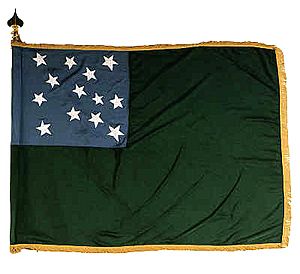
The first European to see Vermont was likely Jacques Cartier in 1535. In 1609, French explorer Samuel de Champlain claimed Vermont for France. The first French settlement was Fort Sainte Anne in 1666.
In 1724, the British built Fort Dummer, their first permanent settlement. This fort protected nearby towns like Dummerston and Brattleboro. The French also built forts, like Fort Saint-Frédéric and Fort Ticonderoga, to control the Lake Champlain area.
During the French and Indian War (1754–1763), Britain fought France for control of North America. Britain won, and France gave up its land, including Vermont, to the British.
After the war, King George III set the border between New Hampshire and New York. This caused problems because both colonies had sold land in the Vermont area. To protect their land, settlers from New Hampshire formed a group called the Green Mountain Boys in 1770. Their leaders included Ethan Allen and Seth Warner.
In 1775, at the start of the American Revolutionary War, the Green Mountain Boys helped capture Fort Ticonderoga from the British.
Becoming an Independent Republic
On January 15, 1777, representatives from the New Hampshire Grants declared their independence. For a short time, they called themselves the Republic of New Connecticut.
On June 2, 1777, they officially changed the name to "Vermont." On July 8, they adopted the Constitution of Vermont. This was the first constitution in North America to ban adult slavery. It stated that male slaves would become free at age 21 and females at 18. Vermont later fully banned slavery in 1858. Vermont also played a key role in the Underground Railroad, helping enslaved people escape to Canada.
Vermont in the Revolutionary War
The Battle of Bennington on August 16, 1777, was a very important event. American forces defeated a British army, which weakened the British. This battle, along with the Battle of Saratoga, was a turning point in the Revolutionary War. Vermont still celebrates the Battle of Bennington as a holiday.
The Battle of Hubbardton (July 7, 1777) was the only Revolutionary War battle fought within Vermont's current borders.
Joining the United States
Vermont governed itself as an independent state for 14 years. It even made its own money and had its own postal service. Thomas Chittenden was the governor during most of this time.
In January 1791, Vermont decided to join the United States. On March 4, 1791, Vermont became the 14th state, the first to join after the original 13 colonies.
The Civil War and Beyond
During the American Civil War, Vermont sent many men to fight for the United States. Over 5,000 Vermonters died in the war. The northernmost land action of the war, the St. Albans Raid, happened in Vermont.
Changes in Population
Starting in the mid-1800s, many immigrants from Ireland, Scotland, and Italy came to Vermont. Many worked as stonecutters in Barre, which was known for its granite. These new residents helped Vermont's population grow.
Natural Disasters
Vermont has experienced several natural disasters. A major flood in 1927 killed 84 people. In 1938, a hurricane blew down a third of New England's forests. Another severe flood happened in 2011 due to Tropical Storm Irene, causing widespread damage.
Political Progress
Vermont was ahead of its time in granting women the right to vote. Women could vote in town elections starting in 1880, decades before it became a national right.
Vermont's Geography
Vermont is in the New England region and covers about 9,614 square miles. It is the 45th largest state. Vermont is the only state without any buildings taller than 124 feet.
The Connecticut River forms Vermont's eastern border with New Hampshire. Lake Champlain is a major lake in Vermont. It is the sixth-largest freshwater body in the U.S. and separates Vermont from New York in the northwest. Vermont is about 159 miles long from north to south. Its widest point is 89 miles at the Canadian border.
The Green Mountains run like a spine through the middle of the state. In the southwest, you'll find the Taconic Mountains. The fertile Champlain Valley is in the northwest, near Lake Champlain.
Several mountains have high-altitude ecosystems, including Mount Mansfield, the state's highest peak. Other tall mountains include Killington Peak, Camel's Hump, and Mount Abraham.
People of Vermont
Population Overview
In 2020, Vermont had a population of 643,085. It is one of the least populated states. The center of Vermont's population is in Washington County, near the town of Warren.
In recent years, more people have moved into Vermont. Chittenden County has seen the fastest growth. Many immigrants have come from Canada, Nepal, Jamaica, the Philippines, and Bosnia and Herzegovina.
Diversity in Vermont
Vermont is one of the least diverse states in the U.S. As of 2022, about 94% of residents identify as White. The largest ancestral group is French, with about 20% of Vermont's population having French heritage. Irish and English people also make up large parts of the population.
Race and Ethnicity In Vermont(2021) White(Non-Hispanic) (92.2%) Hispanic or Latino (2.2%) Asian(Non-Hispanic) (2.0%) Mixed Race (1.9%) Black(Non-Hispanic) (1.3%) American Indian(Non-Hispanic) (0.3%)
Language and Dialects
Linguists have studied the way Vermonters speak. They found that speech patterns in Vermont belong to Western New England English. This dialect fully pronounces all 'r' sounds. It also pronounces words like 'horse' and 'hoarse' the same. Some rural speakers might pronounce 't' as a glottal stop, making 'Vermont' sound like "Vermon'".
Religious Beliefs
| Religion in Vermont (2014) | ||||
|---|---|---|---|---|
| Religion | Percent | |||
| Unaffiliated | 37% | |||
| Protestant | 30% | |||
| Catholic | 22% | |||
| Eastern Orthodox | 1% | |||
| Jewish | 2% | |||
| Hindu | 1% | |||
| Buddhist | 1% | |||
| Other | 3% | |||
| Don't know | 2% | |||
In 2014, a study showed that 37% of Vermonters reported having no religion. This was the highest rate in the U.S. The largest religion in Vermont is Christianity. Catholics make up 22% of the population, and Protestants are 30%. Many Protestants in Vermont are from Mainline Protestant churches.
Vermont's Government
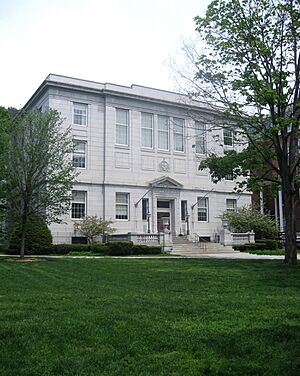
Vermont has a government with three main parts:
- Legislative branch: The Vermont General Assembly makes laws.
- Executive branch: The governor of Vermont leads the state.
- Judicial branch: The Vermont Supreme Court interprets laws.
The governor and members of the General Assembly serve two-year terms. There are no limits on how many terms they can serve. The state capital is Montpelier.
Vermont has towns, cities, and villages. Unlike many other states, counties in Vermont do not have much independent government power. County services, like courts, are funded by the state.
Vermont's Economy
In 2022, Vermont's economy was valued at about $40.6 billion. This makes it the smallest economy among U.S. states. However, its economic output per person ranks 21st.
Canada is Vermont's biggest foreign trade partner. In 2022, over 7,400 new businesses started in Vermont.
Money and Income
In 2021, the average household income in Vermont was $67,674. About 10.3% of the population lived at or below the poverty line. The average hourly wage in 2022 was $22.75.
Farming in Vermont
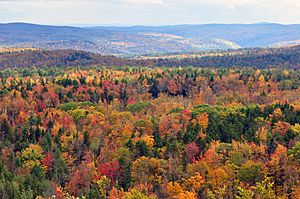
Farming, especially dairy farming, is a big part of Vermont's economy. However, the number of dairy farms has greatly decreased over the years. In 1947, there were over 11,000 dairy farms, but by 2021, there were only 568. Dairy farms still control 80% of the open land in Vermont.
Forestry and Wood Products
Forestry has always been important to Vermont's economy. Over 78% of Vermont's land is forested today. This is a big increase from the 1880s, when much land was cleared for sheep farming. Most of Vermont's forests are secondary forests, meaning they have regrown after being cut down.
Maple Syrup and Apples
Vermont is the top producer of maple syrup in the United States. In 2022, it produced over 2.5 million gallons, which is more than half of the nation's total.
Apple growing is the third largest part of Vermont's agricultural economy. Many orchards now focus on growing apples for cider and for "Pick-Your-Own" visitors. Apples and apple pie are the official state fruit and pie.
Manufacturing and Special Products
GlobalFoundries, a company that makes computer chips, is the largest private employer in Vermont. It has a plant in Essex Junction.
Vermont is also known for making artisan foods and unique items. Famous examples include Ben and Jerry's Ice Cream, Burton Snowboards, Cabot Cheese, and the Vermont Teddy Bear Company. These products are popular because of the "Vermont brand."
Energy in Vermont
Vermont does not have fossil fuels like coal or oil. However, its forests provide fuel for electricity and heating. Vermont uses less electricity per person than most states. In 2019, 99.9% of Vermont's electricity came from renewable sources, the highest in the U.S.
Jobs and Employment
In 2009, Vermont had a high of 361,290 workers. In 2019, the unemployment rate was very low, at 2.2%. About 11% of workers in Vermont are part of a union.
Fun and Recreation
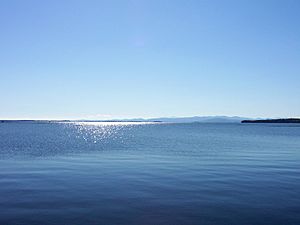
Vermont is a popular place for tourists. In 2005, about 13.4 million people visited the state, spending over $1.5 billion. Fall is a very popular time to visit, especially for seeing the colorful leaves.
Many people own vacation homes in Vermont. In some towns, most houses are owned by people from out of state. Popular vacation spots include Manchester and Stowe.
Hunting and Wildlife
Hunting is controlled for animals like black bears, wild turkeys, deer, and moose. The state tries to keep the number of bears between 4,500 and 6,000. In 2010, there were about 141,000 deer in the state.
Skiing and Snowmobiling

Vermont has some of the largest ski areas in New England. Skiers and snowboarders visit places like Killington Ski Resort, Stowe Mountain Resort, and Jay Peak Resort. Many famous snowboarders, like Hannah Teter and Kelly Clark, are from Vermont or learned to snowboard there.
In winter, many people also enjoy snowmobiling. In 2008, there were 35,000 snowmobiling club members in Vermont. They maintain 6,000 miles of trails.
Quarrying and Stone
The towns of Rutland and Barre are known for quarrying and carving marble and granite. The Rock of Ages quarry in Barre is the largest granite quarry in the U.S. Vermont is also the biggest producer of slate in the country.
Education in Vermont

Vermont has a strong education system. In 2005 and 2006, it was named the nation's smartest state. In 2017, Vermont spent over $21,000 per student in public schools. In 2011, 91% of Vermonters had graduated from high school, which is higher than the national average.
Colleges and Universities
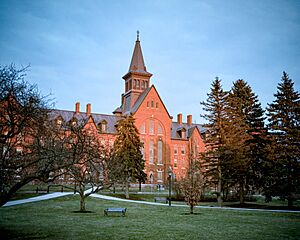
Vermont's largest university is The University of Vermont (UVM). It is a public research university. Other colleges include Vermont State University, Community College of Vermont, Middlebury College, and Norwich University.
Getting Around Vermont
The Vermont Agency of Transportation (VTrans) manages roads and other transportation. Most people in Vermont travel by car. In 2021, 93.4% of households owned a car.
Roads and Highways

In 2012, there were 605,000 vehicles registered in Vermont. This is almost one car for every person. About half of the state's greenhouse gas emissions come from vehicles.
Vermont has 2,840 miles of highway. In 2007, Vermont was ranked the third safest state for highway deaths. Collisions with moose can be a danger, especially in northern Vermont.
Since 1968, Vermont has banned billboards along its roads. This is a source of pride for Vermonters, as it helps keep the scenic views clear.
Main North-South Roads
 Interstate 89 goes from White River Junction northwest through Montpelier, Burlington, and St. Albans to the Canadian border.
Interstate 89 goes from White River Junction northwest through Montpelier, Burlington, and St. Albans to the Canadian border. Interstate 91 runs north-south from Massachusetts to Canada, connecting towns like Brattleboro and Newport.
Interstate 91 runs north-south from Massachusetts to Canada, connecting towns like Brattleboro and Newport. U.S. Route 7 goes north-south in western Vermont, connecting cities like Bennington, Rutland, and Burlington.
U.S. Route 7 goes north-south in western Vermont, connecting cities like Bennington, Rutland, and Burlington. Vermont Route 100 runs through the center of the state, along the Green Mountains. Many ski areas are located near this route.
Vermont Route 100 runs through the center of the state, along the Green Mountains. Many ski areas are located near this route.
Main East-West Roads
 U.S. Route 2 crosses central and northern Vermont from New York to New Hampshire. It connects the Lake Champlain Islands and the Northeast Kingdom to Burlington and Montpelier.
U.S. Route 2 crosses central and northern Vermont from New York to New Hampshire. It connects the Lake Champlain Islands and the Northeast Kingdom to Burlington and Montpelier. U.S. Route 4 runs east-west across south-central Vermont, connecting Rutland and Woodstock.
U.S. Route 4 runs east-west across south-central Vermont, connecting Rutland and Woodstock.
Ferries and Trains
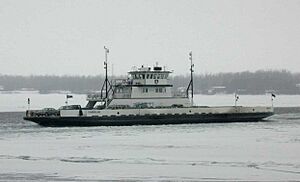
Ferries operate year-round across Lake Champlain to New York State.
Passenger train service is provided by Amtrak with the Vermonter and Ethan Allen Express trains. Freight trains also operate in the state.
Buses and Airports
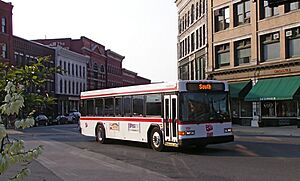
Intercity bus companies like Greyhound Lines and Vermont Translines serve many towns. Local bus services also operate in every Vermont county.

Patrick Leahy Burlington International Airport is the largest airport in Vermont. It has flights to major cities across the U.S. The airport is also home to the "Green Mountain Boys" fighter squadron, which protects the Northeastern United States.
Media and News
Vermont has many newspapers that cover news across the state. These include the Burlington Free Press, Rutland Herald, and Times Argus.
There are 93 radio stations in Vermont. Vermont Public Radio owns many of these. Vermont also has 10 high-power television stations.
Vermont's Culture
Vermont hosts many festivals, such as the Vermont Maple Festival and the Apple Festival. The Vermont Symphony Orchestra performs throughout the state.
Burlington, Vermont's largest city, holds the annual Vermont International Film Festival. The Green Mountain Film Festival is held in Montpelier. The Bread and Puppet Theatre performs weekly shows in Glover.
The rock band Phish is one of Vermont's most famous musical acts. Its members met and started playing in Vermont.
Vermont is known for its strong sense of community. In 2007, Vermont ranked eighth in the nation for volunteerism, with 37% of the population volunteering. In 2011, Vermonters were ranked as the healthiest people in the country.
Sports in Vermont
Winter Sports
Winter sports are very popular in Vermont. Major ski areas include Killington Ski Resort, Stowe Mountain Resort, and Jay Peak Resort. Many Olympic gold medalists in winter sports, like Hannah Teter and Kelly Clark, are from Vermont.
Team Sports
The Vermont Lake Monsters are a professional baseball team based in Burlington. They play in the Futures Collegiate Baseball League.
In basketball, the Vermont Catamounts are the highest-ranked college teams.
Vermont also has a few auto racing tracks, like Thunder Road International Speedbowl in Barre.
Famous Vermonters
Many well-known people were either born in Vermont or lived there for a long time:
- Chester A. Arthur, 21st President of the United States
- Calvin Coolidge, 30th President of the United States
- John Deere, who founded Deere & Company
- Robert Frost, a famous poet
- Rudyard Kipling, a well-known author
- Bernie Sanders, a politician and legislator
- Joseph Smith, founder of the Latter Day Saint movement
Vermont in Stories
- The 1980s TV show Newhart was set in Vermont.
- The novel Pollyanna takes place in Vermont.
- In H. P. Lovecraft's story The Whisperer in Darkness, Vermont is home to a folklorist and strange extraterrestrial beings.
- Sinclair Lewis' novel It Can't Happen Here is largely set in Vermont.
See also
 In Spanish: Vermont para niños
In Spanish: Vermont para niños




